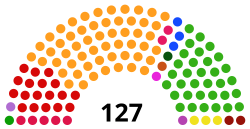National Assembly (Burkina Faso)
|
National Assembly l’Assemblée nationale |
|
|---|---|
| 7th National Assembly | |
 |
|
| Type | |
| Type | |
| Structure | |
 |
|
|
Political groups
|
MPP: 55 seats
UPC: 33 seats
CDP: 18 seats
UNIR / PS: 5 seats
ADF–RDA: 3 seats
NTD: 3 seats
PRN: 2 seats
NAFA: 2 seats
FA: 1 seat
ODT: 1 seat
PDS/Metba: 1 seat
RDS: 1 seat
UBN: 1 seat
MDA: 1 seat
|
| Meeting place | |
 |
|
| Parliament Building, Ouagadougou | |
| Website | |
| www |
|
The unicameral National Assembly is the Burkina Faso's legislative body. In 1995, it became the lower house of a bicameral Parliament, but the upper house (Chamber of Representatives) was abolished in 2002. The upper house was to have been restored under the name "Senate" in the June 2012 constitutional amendments. This revision was never executed due to an extended and unresolved political confrontation over the Senate's establishment, which left the country effectively with a unicameral legislature as of the October 2014 constitutional crisis.
On 30 October 2014, as part of the 2014 Burkinabé uprising, protesters stormed the parliament building and set fire to it, in anger at the Parliament's decision to amend the Constitution of Burkina Faso to abolish term limits, which would have effectively paved the way for President Blaise Compaoré to remain in office for another five-year term.
Burkina Faso is divided into 45 electoral provinces within their 13 regions. Each province elects between two and nine representatives, and these representatives are members of political parties. There are 111 members of the National Assembly elected to represent provinces, and 16 nationally elected, totaling 127.
In Burkina Faso, the National Assembly is elected by a proportional representational system. Proportional representation in Burkina Faso means that each person marks one party on the ballot, and after tallying the votes, the top parties chosen are elected to the Assembly. Each electoral province has a simple electoral quotient. This is the number of valid votes counted divided by the number of seats available. If a party wins a seat by the electoral quotient, usually half of the votes, then the remainder of the seats are transferred to a "rest" category, which are compared to the other votes gathered. For example, in the province of Boulkiemde, the MPP received 29,445 votes, which is 35.1% of the total votes of the province. Boulkiemde elects four representatives to their legislature, so their electoral quotient is 21002 votes (84007÷4). This means that the MPP will receive one seat from the electoral quotient. The remaining votes are transferred to another category, which is compared among the other candidates. These remaining votes in Boulkiemde won the MPP another seat in the legislature, since the remaining votes (8443) are the second highest compared to the rest of the parties (CDP=16968, UPC=8099). Thus, since the MPP received 35.1% of the votes, they received 50% of the seats due to the electoral quotient.
...
Wikipedia
